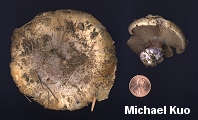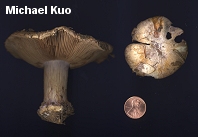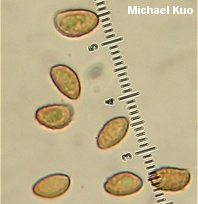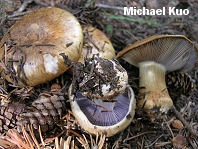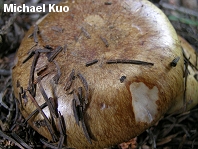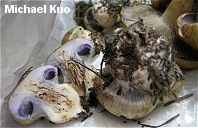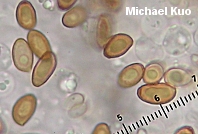| Major Groups > Gilled Mushrooms > Dark-Spored > Cortinarius > Cortinarius glaucopus |

|
Cortinarius glaucopus group [Basidiomycetes > Agaricales > Cortinariaceae > Cortinarius ... ] by Michael Kuo I suspect there are quite a few North American members of the Cortinarius glaucopus species group, inhabiting a wide variety of ecosystems. The species was first described in 1774, from Germany, and defining it precisely has always been a challenge, even in Europe (for the most precise contemporary European concept of the species, see Knudsen & Vesterholt, 2008). Here I am using the name in the wide sense to represent North American Cortinarius species that share the following features:
Illustrated are two very different collections: one from an Illinois white pine plantation and one from an Engelmann spruce-subalpine fir forest in southwestern Colorado. The description below encompasses the North American Cortinarius glaucopus group as a whole. Description: Ecology: Mycorrhizal with conifers (especially) or hardwoods; growing scattered or gregariously; summer and fall, or over winter in warmer climates; widely distributed in North America. Cap: 3-12 cm; convex, becoming broadly convex or nearly flat; sticky when fresh and young, but often dry when collected; bald over the center and silky toward the margin; developing radial streaks of innate fibers; variable in color, ranging from grayish olive to steely gray, yellowish brown, rusty brown (or even bluish when young); the margin often notably paler (grayish to yellowish or olive), and often becoming wavy. Gills: Attached to the stem, sometimes by a notch; close; lilac to pale purple at first, becoming rusty brown (often after a gray to grayish stage). Stem: 4-10 cm long; to nearly 3 cm thick; more or less equal above a truncated, rimmed (at least when young), slightly bulbous base; usually lilac to pale purple when fresh and young, but often brownish to yellowish or dull olive with age; dry; often with rusty cortina remnants. Flesh: Whitish to yellowish, or purplish in the stem apex or near the gills. Odor and Taste: Not distinctive. Chemical Reactions: KOH pinkish to reddish on cap, brownish on flesh. Spore Print: Rusty brown. Microscopic Features: Spores 6-10 x 4-5.5 µ; ellipsoid to slightly amygdaliform; weakly verrucose. Pleuro- and cheilocystidia absent. Pileipellis an ixocutis (sometimes only slightly gelatinized) with clamped elements. REFERENCES: (Schaeffer, 1774) Fries, 1838. (Fries, 1821; Saccardo, 1887; Kauffman, 1918; Kauffman, 1932; Smith, 1939; Smith, 1942; Smith, Smith & Weber, 1979; Arora, 1986; States, 1990; Phillips, 1991/2005; Lincoff, 1992; Evenson, 1997; Miller & Miller, 2006; Knudsen & Versterholt, 2008.) Herb. Kuo 11120401, 08140804. Herb. DBG RMNP 2008-115. This site contains no information about the edibility or toxicity of mushrooms. |
ILLINOIS:
COLORADO:
© MushroomExpert.Com |
|
Cite this page as: Kuo, M. (2012, January). Cortinarius glaucopus group. Retrieved from the MushroomExpert.Com Web site: http://www.mushroomexpert.com/cortinarius_glaucopus.html |
